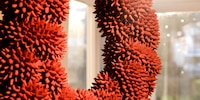
Background information
From volcanoes to the Alps – when Mexican design meets Swiss expertise
by Pia Seidel

Seemingly light-weight things like a balloon can have quite a large impact on the environment. That’s why product designer Maxwell Ashford has created an alternative that looks just as festive but is biodegradable.
As a child, I loved balloons. I wanted to watch it fly. But I didn’t really want to let it go without knowing where it will end up. Today, letting balloons fly has a bitter aftertaste for me because I know that if they don’t happen to end their journey in the rubbish bin, they pollute the environment. The redesign by Maxwell Ashford is all the more exciting. The designer has created an object called Bamana, which can have the same magical effect of a balloon and is environmentally friendly.
Bamana can’t fly, but it can float. The hanging object is suitable for indoor and outdoor use. It contains neither adhesives nor plastics and is composed of small individual shapes. These are formed from recycled paper and wastewater, coloured with vegetable food dyes, and filled with recycled paper confetti at the end. The material can decompose when wet or be disposed of with the rest of the household recycling paper.


Maxwell Ashford’s work focuses on sustainable innovation and the environmental impacts associated with the production and consumption of everyday objects. He holds an MA in Product Design from ECAL (École cantonale d'art de Lausanne) and currently lives in Lausanne. A few years ago, he noticed more and more balloons stranded by the sea, so one day he started looking into the floating object and designed Bamana for the Nov Gallery in Geneva. «The balloon is a floating airbag that symbolises joy and celebration and brings beautiful moments to places like children’s hospitals,» Maxwell says. «At the same time, it’s one of the ten most common single-use plastic items found on European beaches and is deadly to birds and marine life because they can choke on it.»
With his substitute, the designer wants people to be able to use a party object without hesitation until the very end of its life, and for it to bring joy like a balloon. That’s where the little piñatas come into play. They can be torn apart during a celebration and if you blow or shake them, the confetti will come out.
This gesture is intended to emphasise the elusiveness that is so important for celebratory events and spreading joy. The colours and unusual shapes also give Bamana a festive character. They’re inspired by seeds, spores or pollen and are intended to arouse curiosity. The idea for the name Bamana comes from an old object from Mali that was used on birthdays. This influenced earlier versions of the decorative hanging object. But they’re no longer visible in the final version.
If the Bamana lands in water, the material will disintegrate. However, since the object isn’t filled with helium and doesn’t fly, it shouldn’t even get close to lakes or seas. That was key for Maxwell. «In the best-case scenario, Bamana goes in the household paper recycling stream and can be reused,» Maxwell says. «Worst case scenario, it dissolves altogether.»

Bamana is still more of a speculative design than a product you buy. However, Maxwell hopes his design will give users food for thought and bring about a change in commerce. «The lobbying power of balloon manufacturers is surprisingly strong in a market littered with greenwashing.» Conventional foil balloons are entirely made from fossil-based plastics and therefore never biodegrade. But natural latex balloons also have a catch because they contain plasticizers that prevent or slow down the biological decomposition process. In addition, both balloons use helium, which is becoming increasingly valuable, according to the designer.
Should a company be interested in manufacturing Banama, Maxwell said he would be open to further developing the object. Then it would first need a verification to ensure complete biodegradability, and later, enough consumers who want to drive the change. I’d certainly be one of the first to switch to Bamana. I don’t think I’d have missed out as a child. Quite the opposite, in fact, I’d have enjoyed the benefits because it would have been easier for me to let go of the balloon. It wouldn’t have flown away. Instead, I’d be sure that the flying confetti was guaranteed to land at my feet instead of in the middle of nowhere.

Like a cheerleader, I love celebrating good design and bringing you closer to everything furniture- and interior design- related. I regularly curate simple yet sophisticated interior ideas, report on trends and interview creative minds about their work.